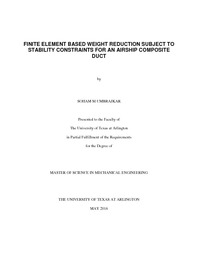
ATTENTION: The works hosted here are being migrated to a new repository that will consolidate resources, improve discoverability, and better show UTA's research impact on the global community. We will update authors as the migration progresses. Please see MavMatrix for more information.
Show simple item record
| dc.contributor.advisor | Dancila, Dragos Stefan | |
| dc.creator | Umbrajkar, Soham M. | |
| dc.date.accessioned | 2016-07-08T19:56:31Z | |
| dc.date.available | 2016-07-08T19:56:31Z | |
| dc.date.created | 2016-05 | |
| dc.date.issued | 2016-05-10 | |
| dc.date.submitted | May 2016 | |
| dc.identifier.uri | http://hdl.handle.net/10106/25763 | |
| dc.description.abstract | The primary functions of High Altitude Long Endurance (HALE) airships are persistent observation and wide area direct line of sight communication. Traditional airships have an ellipsoidal type hull, which is characterized by a large aspect ratio but results in an increase in the weight of the envelope. In order to reduce the weight of an airship, a hull having lower aspect ratio would be preferred. A novel unconventional airship design having a toroidal geometry with a propulsive duct running from the front end to back end was developed by Dancila in an attempt to achieve this objective. The propulsive duct helps in reducing the drag associated with the toroidal shape by blowing of the wake region. The propulsive duct is subjected to hull pressure on its outer walls and airflow induced pressure on its inner walls. This results in in-plane duct wall compressive stress, which may potentially result in a loss of structural stability. In prior work a duct with sandwich composite configuration was investigated, to maintain an open duct, as it offers high specific stiffness, high specific strength and lightweight alternative to isotropic material construction. In this thesis a corrugated sandwich composite duct design is considered as it may provide a higher wall bending stiffness compared to a smooth duct. The results for the smooth sandwich composite duct obtained from the literature survey are used as a reference in this analysis. The duct is modeled and analyzed using the commercial finite element code ABAQUS. The objective is to reduce weight subject to stability constraints while maintaining a 50% margin of safety. There are two independent design parameters and one dependent design parameter for this analysis. The independent design parameters are the number of corrugation waves and amplitude of corrugation while the dependent parameter is the required thickness of the foam to ensure stability. An FEM based method is used to reduce the weight of the corrugated duct design involving number of corrugation waves, amplitude of corrugation and foam thickness. The best configuration identified in this investigation provides a significant weight reduction of 32% compared to the baseline smooth duct. | |
| dc.format.mimetype | application/pdf | |
| dc.language.iso | en_US | |
| dc.subject | Sandwich composite duct | |
| dc.subject | Corrugated duct | |
| dc.subject | Airship duct | |
| dc.subject | Finite element method | |
| dc.subject | Weight optimization | |
| dc.title | FINITE ELEMENT BASED WEIGHT REDUCTION SUBJECT TO STABILITY CONSTRAINTS FOR AN AIRSHIP COMPOSITE DUCT | |
| dc.type | Thesis | |
| dc.degree.department | Mechanical and Aerospace Engineering | |
| dc.degree.name | Master of Science in Mechanical Engineering | |
| dc.date.updated | 2016-07-08T19:58:39Z | |
| thesis.degree.department | Mechanical and Aerospace Engineering | |
| thesis.degree.grantor | The University of Texas at Arlington | |
| thesis.degree.level | Masters | |
| thesis.degree.name | Master of Science in Mechanical Engineering | |
| dc.type.material | text | |
| dc.creator.orcid | 0000-0001-9848-9825 | |
Files in this item
- Name:
- UMBRAJKAR-THESIS-2016.pdf
- Size:
- 2.171Mb
- Format:
- PDF
This item appears in the following Collection(s)
Show simple item record


